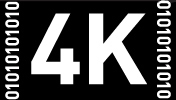

Jean-Luc Godard’s 69-minute meditation on himself and his relation to the world, humanity, and cinema is more a personal video essay than a feature film. Yet this creation is no mere work of conceptual video art. It does far more that randomly juxtapose image and sound to achieve a grandiloquent statement or evoke a fleeting emotional response. This philosophical, abstract film impishly defies any attempts to decipher its meaning, rendering it too amusing to be dismissed as heavy or pompous. Goodbye to Language stars Godard’s dog, filmed home-movie style as he explores the forest (which, the director lets us know, is the Apache word for “the world.”), and an adulterous couple (Héloise Godet and Kamel Abdeli) who argue, fight, undress, and fart. Godard made his career walking the line between profound and pretentious, and, though Goodbye to Language is more the later than the former, its undeniably an innovative, oblique think piece.
This is the first 3D feature
by the legendary French auteur, and he pulls off some bold experiments with the
much derided and overused format. Some are calling this the greatest 3D film
ever made, but I can’t go along with that. Certainly this is a film that MUST
be seen in 3D, but Goodbye to Language
does not change my view that there have only been four really excellent 3D
films: Dial M For Murder (1954) and Pina (2011), which use the format to
recreate the theatricality and proscenium perspective of live performance, and Life of Pi (2012) and Gravity (2013), which use the illusion
of depth to represent infinite environments--the vastness of the ocean and the
eternity of outer space. While it might seem like the new emphasis on 3D
ushered in by Avatar (2009) has
yielded one great movie a year, I think 2014 will break that brief streak.
Godard does some truly impressive things with the 3D medium, specifically the
placement of different colors or entirely different images in each of the
viewer’s eyes. He breaks certain rules of the technology to disorient us, resulting
in new ways of perceiving filmed images. He manipulates his multi-dimensional shots
to expand the 3D vernacular, as he similarly challenged and rewrote the
language of cinema itself in the 1960s. Then his jumpcuts, continuity
violations, and disregard for character sightlines deconstructed, skewed, and
skewered classical Hollywood techniques. But what he achieved in films like Breathless (1960), Pierrot le Fou (1965), and Weekend
(1967), was revolutionary in that it forever changed what a movie could be. The
effects he creates in Goodbye to Language
are innovative, but only because no one else has thought to try them yet. They will
not change the future of cinema. Cinema is now of an age where it’s beyond the
ability of one director to influence it to the degree Godard did fifty years
ago.
Goodbye to Language cannot be faulted for not changing the face of filmmaking, but it shouldn’t be overpraised or considered a landmark of film history, or even of 2014. I’m certainly glad I saw it. It’s a stimulating, often funny commentary on Western society, which Godard seems to think may be at some kind of tipping point. After 83 years and 39 feature films, he appears more amused than concerned about what life will be like when he’s gone.





